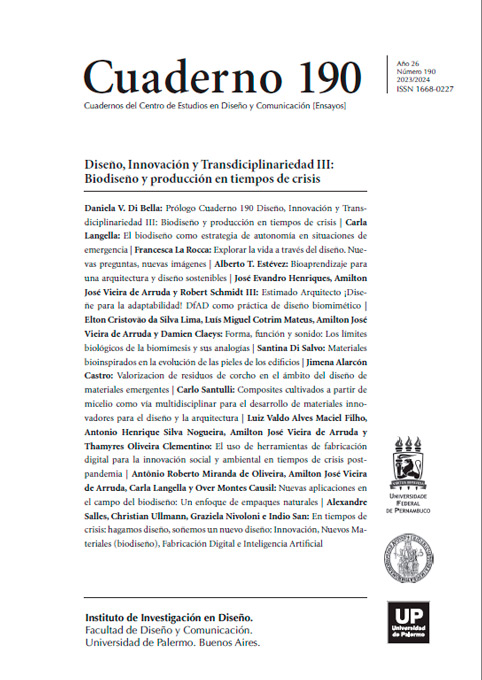Valorización de residuos de corcho en el ámbito del diseño de materiales emergentes
Resumo
O manuscrito deriva da experimentação realizada para projetar materiais com uma abordagem sustentável baseada no uso de resíduos de cortiça na forma de rolhas de cortiça de embalagens domésticas.
Referências
Alarcón, J., Rognoli, V., & Llorens, A. (2020). Diseñar para un escenario social incierto. El valor del enfoque materiales Do-It-Yourself y economía circular. Interciencia, 45(6), 279-285.
Alarcón, J., Westermeyer, J., Di Bartolo, C., & Castillo, C. D. (2015). Valorización de cuero de vacuno residual de manufactura de calzado, como estrategia sustentable para elaboración de tableros De Pinus radiata EN Bío-Bío, Chile. Interciencia, 40(2), 138-144.
Ashby, M. F. (2012). Materials and the environment: eco-informed material choice. Elsevier.
Ashby, M. F. (2016). Chapter 1—Background: Materials, Energy and Sustainability. Materials and Sustainable Development; Ashby, MF, Ed.; Butterworth-Heinemann: Boston, MA, USA, 1-25.
Barati, B., Karana, E., & Hekkert, P. (2019). Prototyping materials experience: Towards a shared understanding of underdeveloped smart material composites. International Journal of Design, 13(2), 21-38.
Beylerian, G. M., Dent, A., & Quinn, B. (2008). Ultramateriales: formas en que la innovación en los materiales cambia el mundo. Blume.
Bergström, J., Clark, B., Frigo, A., Mazé, R., Redström, J., & Vallgårda, A. (2010). Becoming materials: material forms and forms of practice. Digital Creativity, 21(3), 155-172.
Blanpain, B., Meskers, C. E., Olivetti, E., Apelian, D., Howarter, J., Kvithyld, A., & Spangenberger, J. S. (2016). REWAS 2016: Towards materials resource sustainability. John Wiley & Sons.
Costa, C., Viana, A., Silva, C., Marques, E. F., & Azoia, N. G. (2022). Recycling of textile wastes, by acid hydrolysis, intonew cellulosic raw materials. Waste Management, 153, 99-109.https://doi.org/10.1016/j.wasman.2022.08.019
Ceschin F., & Gaziulusoy, I. (2016). Evolution of design forsustainability: From product design to design for systeminnovations and transitions. Design studies, 47: 118-163. https://doi.org/10.1016/j.destud.2016.09.002
Fernandes, E. M., Correlo, V. M., Chagas, J. A., Mano, J. F., & Reis, R. L. (2011). Properties of new cork–polymer composites: advantages and drawbacks as compared with commercially available fibreboard materials. Composite structures, 93(12), 3120-3129.
Giaccardi, E., & Karana, E. (2015). Foundations of materials experience: An approach for HCI. In Proceedings of the 33rd Annual ACM Conference on Human Factors in Computing Systems (pp. 2447-2456).Gil, L. (2015). New cork-based materials and applications. Materials, 8(2), 625-637.
Happaerts, S. (2014). International Discourses and Practices of Sustainable Materials Management, Policy Research Centre for Sustainable Materials Management, Report number: n° 5, Leuven. 12-13 pp.
Karana, E., Nimkulrat, N., Giaccardi, E., Niedderer, K., & Fan, J. N. (2019). Alive. Active. Adaptive: Experiential knowledge and emerging materials. International Journal of Design, 13(2), 1-5.
Karana, E., Barati, B., Rognoli, V., & Zeeuw Van Der Laan, A. (2015). Material driven design (MDD): A method to design for material experiences. International journal of design, 9(2), 35-54.
López, Y. M., González, M. G., & Rodríguez, E. M. (2014). Impacto ambiental de residuos industriales de aserrín y plástico. Usos para la industria de tablero en Cuba. Avances, 16(2), 91-99.
Mestre, A. (2015). A design action intervention approach in the cork industry towards sustainable product innovation. Journal of Design Research, 13(2), 185-235.
Mestre, A., & Vogtlander, J. (2013). Eco-efficient value creation of cork products: an LCA-based method for design intervention. Journal of Cleaner Production, 57, 101-114.
Parisi, S., Rognoli, V., & Sonneveld, M. (2017) Material Tinkering. An inspirational approach for experiential learning and envisioning in product design education. The Design Journal, 20(sup1), S1167-S1184. https://doi.org/10.1080/14606925.2017.1353059
Pedgley, O., Rognoli, V., & Karana, E. (2021). Expanding territories of materials and design. In Materials Experience 2 (pp. 1-12). Butterworth-Heinemann.
Pintor, A. M., Silvestre-Albero, A. M., Ferreira, C. I., Pereira, J. P., Vilar, V. J., Botelho, C. M., ... & Boaventura, R. A. (2013). Textural and surface characterization of cork-based sorbents for the removal of oil from water. Industrial & Engineering Chemistry Research, 52(46), 16427-16435.
Sauerwein, M., Karana, E., & Rognoli, V. (2017). Revived beauty: research into aesthetic appreciation of materials to valorise materials from waste. Sustainability, 9(4), 529.
Sierra-Pérez, J., López-Forniés, I., Boschmonart-Rives, J., & Gabarrell, X. (2016). Introducing eco-ideation and creativity techniques to increase and diversify the applications of eco-materials: The case of cork in the building sector. Journal of cleaner production, 137, 606-616.
Smol, M., Kulczycka, J., & Avdiushchenko, A. (2017). Circular economy indicators in relation to eco-innovation in European regions. Clean Technologies and Environmental Policy, 19, 669-678.
Technische Universiteit Delft. (2013). Final Report Summary - LIGHT.TOUCH.MATTERS (Design driven development of touch sensitive luminous flexible plastics for applications in care & well-being). Recuperado el 30 de enero de 2023 de https://cordis.europa.eu/project/id/310311/reporting
Yoon, J., Kim, C., & Yoon, J. (2020). Positive user experience over product usage life cycle and the influence of demographic factors.
Los autores/as que publiquen en esta revista ceden los derechos de autor y de publicación a "Cuadernos del Centro de Estudios de Diseño y Comunicación", Aceptando el registro de su trabajo bajo una licencia de atribución de Creative Commons, que permite a terceros utilizar lo publicado siempre que de el crédito pertinente a los autores y a esta revista.


